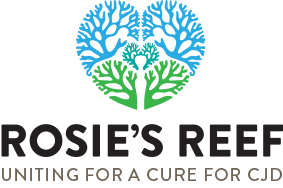About Prion Disease
Understanding Creutzfeldt-Jakob Disease (CJD)
A Rare but Serious Brain Disorder Caused by Prions
🔬 What Is a Prion?
A prion is a misfolded protein that can induce other proteins in the brain to misfold. Unlike viruses or bacteria, prions contain no genetic material but can still propagate and cause damage. As they accumulate, they form clumps that destroy brain cells and create sponge-like holes in brain tissue, leading to a class of diseases known as spongiform encephalopathies.
🧾 Types of CJD
- Sporadic CJD (sCJD): The most common form (~85%). It appears without a known cause and typically affects people over age 60.
- Familial CJD (fCJD): Caused by inherited mutations in the prion protein gene. It accounts for about 10–15% of cases.
- Iatrogenic CJD (iCJD): Acquired through medical procedures, such as contaminated surgical instruments or tissue transplants. Very rare today.
- Variant CJD (vCJD): Linked to consuming beef contaminated with BSE (“mad cow disease”). Affects younger individuals and has distinct symptoms.
🧠 Symptoms of CJD
Symptoms typically develop rapidly and worsen over time. They may include:
- Memory loss and confusion
- Behavior or personality changes
- Blurred or double vision
- Muscle stiffness or twitching
- Balance and coordination problems
- Difficulty speaking or swallowing
- Coma in advanced stages
🩺 Diagnosis
Diagnosis is based on clinical history and a combination of tests, including:
- EEG (Electroencephalogram)
- MRI brain scans
- CSF analysis for specific proteins (e.g., 14-3-3)
- Genetic testing for inherited forms
- Brain biopsy/autopsy (definitive diagnosis)
⚕️ Is There a Cure?
There is no cure for CJD. Treatment focuses on relieving symptoms and making the patient as comfortable as possible. Research is ongoing to better understand prion diseases and find effective therapies.
🔒 Is CJD Contagious?
CJD is not spread through casual contact. Rare cases of transmission have occurred through contaminated surgical tools or tissue transplants, which is why stringent sterilization and donor screening practices are in place.
📉 How Common Is CJD?
CJD is extremely rare, affecting approximately 1 in 1 million people worldwide per year. Sporadic CJD is the most common form, while variant and iatrogenic cases are very rare.
🧬 Research and Hope
Researchers are investigating:
- How prions cause disease
- Early detection methods
- Potential treatments to slow or halt disease progression
- Vaccines and therapeutic drugs
📚 Learn More
Explore more information and resources:

Get in Touch. Get Involved.
Contact us for more info or to volunteer!
